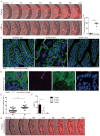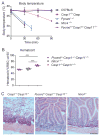NAIP-NLRC4 Inflammasomes Coordinate Intestinal Epithelial Cell Expulsion with Eicosanoid and IL-18 Release via Activation of Caspase-1 and -8
- PMID: 28410991
- PMCID: PMC5476318
- DOI: 10.1016/j.immuni.2017.03.016
NAIP-NLRC4 Inflammasomes Coordinate Intestinal Epithelial Cell Expulsion with Eicosanoid and IL-18 Release via Activation of Caspase-1 and -8
Abstract
Intestinal epithelial cells (IECs) form a critical barrier against pathogen invasion. By generation of mice in which inflammasome expression is restricted to IECs, we describe a coordinated epithelium-intrinsic inflammasome response in vivo. This response was sufficient to protect against Salmonella tissue invasion and involved a previously reported IEC expulsion that was coordinated with lipid mediator and cytokine production and lytic IEC death. Excessive inflammasome activation in IECs was sufficient to result in diarrhea and pathology. Experiments with IEC organoids demonstrated that IEC expulsion did not require other cell types. IEC expulsion was accompanied by a major actin rearrangement in neighboring cells that maintained epithelium integrity but did not absolutely require Caspase-1 or Gasdermin D. Analysis of Casp1-/-Casp8-/- mice revealed a functional Caspase-8 inflammasome in vivo. Thus, a coordinated IEC-intrinsic, Caspase-1 and -8 inflammasome response plays a key role in intestinal immune defense and pathology.
Keywords: ASC; Caspase-1; Caspase-8; Naip; Nlrc4; expulsion; extrusion; inflammasome; intestinal epithelial cell.
Copyright © 2017 Elsevier Inc. All rights reserved.
Conflict of interest statement
The authors declare no competing financial interests.
Figures






Comment in
-
Cell-Intrinsic Defense at the Epithelial Border Wall: Salmonella Pays the Price.Immunity. 2017 Apr 18;46(4):522-524. doi: 10.1016/j.immuni.2017.03.021. Immunity. 2017. PMID: 28423331
References
MeSH terms
Substances
Grants and funding
LinkOut - more resources
Full Text Sources
Other Literature Sources
Molecular Biology Databases
Miscellaneous

